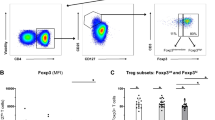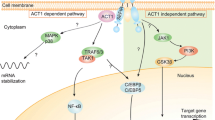Abstract
Psoriatic arthritis is characterized by chronic inflammation of the skin and synovial joint. T cells are abundant in the inflamed joint and skin. Disease susceptibility is associated with major histocompatibility complex, which presents antigens to T cells. T cells in the synovial joints have an activated phenotype and demonstrate selective T-cell receptor usage suggestive of oligoclonal expansions. Taken together, these facts suggest that psoriatic arthritis is driven by antigen or autoantigen-driven T-cell activation. The therapeutic benefit of anti-T-cell agents further supports an important pathogenic role for T cells in persistent synovial inflammation and joint damage in psoriatic arthritis.
Similar content being viewed by others
References and Recommended Reading
Wright V, Moll JM: Psoriatic arthritis. Bull Rheum Dis 1971, 21:627–632.
Taylor W, Gladman D, Helliwell P, et al.: Classification criteria for psoriatic arthritis: development of a new criteria from a large international study. Arthritis Rheum 2006, 54:2665–2673.
Husted JA, Tom BD, Farewell VT, et al.: A longitudinal study of the effect of disease activity and clinical damage on physical function over the course of psoriatic arthritis: Does the effect change over time? Arthritis Rheum 2007, 56:840–849.
Bond SJ, Farewell VT, Schentag CT, Gladman DD: Predictors for radiological damage in psoriatic arthritis: results from a single center. Ann Rheum Dis 2007, 66:370–376.
Rahman P, Elder JT: Genetic epidemiology of psoriasis and psoriatic arthritis. Ann Rheum Dis 2005, 64:37–39.
Baker BS, Swain AF, Valdimarsson H, Fry L: T-cell subpopulations in the blood and skin of patients with psoriasis. Br J Dermatol 1984, 110:37–44.
Petzelbauer P, Pober JS, Keh A, Braverman IM: Inducibility and expression of microvascular endothelial adhesion molecules in lesional, perilesional, and uninvolved skin of psoriatic patients. J Invest Dermatol 1994, 103:300–305.
Oxholm A: Epidermal expression of interleukin-6 and tumour necrosis factor-alpha in normal and immunoinflammatory skin states in humans. APMIS Suppl 1992, 24:1–32.
Davison SC, Ballsdon A, Allen MH, Barker JN: Early migration of cutaneous lymphocyte-associated antigen (CLA) positive T cells into evolving psoriatic plaques. Exp Dermatol 2001, 10:280–285.
Pitzalis C, Cauli A, Pipitone N, et al.: Cutaneous lymphocyte antigen-positive T lymphocytes preferentially migrate to the skin but not to the joint in psoriatic arthritis. Arthritis Rheum 1996, 39:137–145.
Alegre VA, MacDonald DM, Poulter LW: The simultaneous presence of Langerhans’ cell and interdigitating cell antigenic markers on inflammatory dendritic cells. Clin Exp Immunol 1986, 64:330–333.
Chong BF, Wong HK: Immunobiologics in the treatment of psoriasis. Clin Immunol 2007, 123:129–138.
Krueger GG, Papp KA, Stough DB, et al.: A randomized, double-blind, placebo-controlled phase III study evaluating efficacy and tolerability of 2 courses of alefacept in patients with chronic plaque psoriasis. J Am Acad Dermatol 2002, 47:821–833.
Ortonne JP, Lebwohl M, Em Griffiths C, Alefacept Clinical Study Group: Alefacept-induced decreases in circulating blood lymphocyte counts correlate with clinical response in patients with chronic plaque psoriasis. Eur J Dermatol 2003, 13:117–123.
Jullien D, Prinz JC, Langley RG, et al.: T-cell modulation for the treatment of chronic plaque psoriasis with efalizumab (Raptiva): mechanisms of action. Dermatology 2004, 208:297–306.
Gordon KB, Papp KA, Hamilton TK, et al.: Efalizumab for patients with moderate to severe plaque psoriasis: a randomized controlled trial. JAMA 2003, 290:3073–3080.
van Kuijk AW, Reinders-Blankert P, Smeets TJ, et al.: Detailed analysis of the cell infiltrate and the expression of mediators of synovial inflammation and joint destruction in the synovium of patients with psoriatic arthritis: implications for treatment. Ann Rheum Dis 2006, 65:1551–1557.
Veale DJ, Ritchlin C, FitzGerald O: Immunopathology of psoriasis and psoriatic arthritis. Ann Rheum Dis 2005, 64(Suppl 2):ii26–29.
Canete JD, Santiago B, Cantaert T, et al.: Ectopic lymphoid neogenesis in psoriatic arthritis. Ann Rheum Dis 2007, 66:720–726.
Costello P, Bresnihan B, O’Farrelly C, FitzGerald O: Predominance of CD8+ T lymphocytes in psoriatic arthritis. J Rheumatol 1999, 26:1117–1124.
Laloux L, Voisin MC, Allain J, et al.: Immunohistological study of entheses in spondyloarthropathies: comparison in rheumatoid arthritis and osteoarthritis. Ann Rheum Dis 2001, 60:316–321.
Zenz R, Eferl R, Kenner L, et al.: Psoriasis-like skin disease and arthritis caused by inducible epidermal deletion of Jun proteins. Nature 2005, 437:369–375. [Erratum in: Nature 2006, 440:708.]
Daoussis D, Antonopoulos I, Andonopoulos AP, Liossis SN: Increased expression of CD154 (CD40L) on stimulated T-cells from patients with psoriatic arthritis. Rheumatology 2007, 46:227–231.
Raffeiner B, Dejaco C, Duftner C: Between adaptive and innate immunity: TLR4-mediated perforin production by CD28null T-helper cells in ankylosing spondylitis. Arthritis Res Ther 2005, 7:R1412–1420.
Tassiulas I, Duncan SR, Centola M, et al.: Clonal characteristics of T cell infiltrates in skin and synovium of patients with psoriatic arthritis. Human Immunol 1999, 60:479–491.
Costello PJ, Winchester RJ, Curran SA, et al.: Psoriatic arthritis joint fluids are characterized by CD8 and CD4 T cell clonal expansions that appear antigen driven. J Immunol 2001, 166:2878–2886.
Curran SA, FitzGerald OM, Costello PJ, et al.: Nucleotide sequencing of psoriatic arthritis tissue before and during methotrexate administration reveals a complex inflammatory t cell infiltrate with very few clones exhibiting features that suggest they drive the inflammatory process by recognizing autoantigens. J Immunol 2004, 172:1935–1944.
Tan LC, Mowat AG, Fazou C, et al.: Specificity of T cells in synovial fluid: high frequencies of CD8+ T cells that are specific for certain viral epitopes. Arthritis Res 2000, 2:154–164.
Partsch G, Wagner E, Leeb BF, et al.: T cell derived cytokines in psoriatic arthritis synovial fluids. Ann Rheum Dis 1998, 57:691–693.
Szodoray P, Alex P, Chappell-Woodward CM, et al.: Circulating cytokines in Norwegian patients with psoriatic arthritis determined by a multiplex cytokine array system. Rheumatology 2007, 46:417–425.
Horowitz MC, Xi Y, Wilson K, Kacena MA: Control of osteoclastogenesis and bone resorption by members of the TNF family of receptors and ligands. Cytokine Growth Factor Rev 2001, 12:9–18.
Ritchlin CT, Haas-Smith SA, Li P, et al.: Mechanisms of TNF-alpha-and RANKL-mediated osteoclastogenesis and bone resorption in psoriatic arthritis. J Clin Invest 2003, 111:821–831.
Colucci S, Brunetti G, Cantatore FP, et al.: Lymphocytes and synovial fluid fibroblasts support osteoclastogenesis through RANKL, TNFalpha, and IL-7 in an in vitro model derived from human psoriatic arthritis. J Pathol 2007, 212:47–55.
Goedkoop AY, Kraan MC, Teunissen MB, et al.: Early effects of tumour necrosis factor alpha blockade on skin and synovial tissue in patients with active psoriasis and psoriatic arthritis. Ann Rheum Dis 2004, 63:769–773.
Kraan MC, van Kuijk AW, Dinant HJ, et al.: Alefacept treatment in psoriatic arthritis: reduction of the effector T cell population in peripheral blood and synovial tissue is associated with improvement of clinical signs of arthritis. Arthritis Rheum 2002, 46:2776–2784.
Papp KA, Caro I, Leung HM, et al.: Efalizumab for the treatment of psoriatic arthritis. J Cutan Med Surg 2007, 11:57–66.
Author information
Authors and Affiliations
Corresponding author
Rights and permissions
About this article
Cite this article
Choy, E. T cells in psoriatic arthritis. Curr Rheumatol Rep 9, 437–441 (2007). https://doi.org/10.1007/s11926-007-0071-5
Published:
Issue Date:
DOI: https://doi.org/10.1007/s11926-007-0071-5




